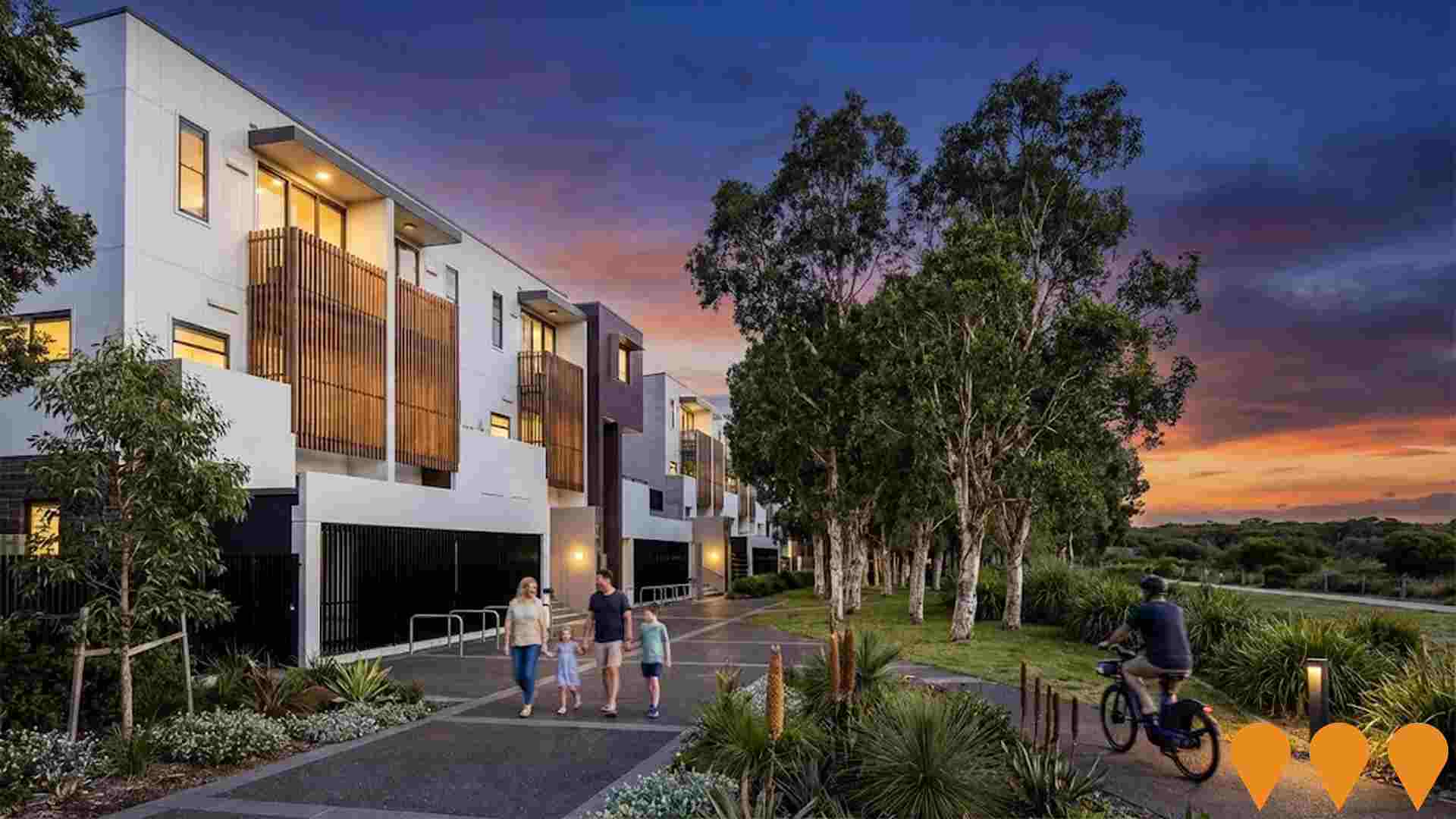Chart Color Schemes
est. as @ -- *
ABS ERP | -- people | --
2021 Census | -- people
Sales Activity
Curious about local property values? Filter the chart to assess the volume and appreciation (including resales) trends and regional comparisons, or scroll to the map below view this information at an individual property level.
Find a Recent Sale
Sales Detail
Population
Forster-Tuncurry Surrounds lies within the top quartile of areas nationally for population growth performance according to AreaSearch analysis of recent, and medium to long-term trends
Forster-Tuncurry Surrounds' population was 6,988 as of Aug 2021. By Aug 2025, it is around 7,223, an increase of 235 people (3.4%). This growth is inferred from ABS estimated resident population of 7,219 in June 2024 and 49 new addresses since the Census date. The population density is 9.6 persons per square kilometer. Forster-Tuncurry Surrounds' growth exceeded its SA3 area's 1.9% increase since Aug 2021. Interstate migration contributed approximately 69.5% of overall population gains during recent periods, with all drivers being positive factors.
AreaSearch uses ABS/Geoscience Australia projections for each SA2 area, released in 2024 with a base year of 2022. For areas not covered by this data, NSW State Government's SA2 level projections are used, released in 2022 with a base year of 2021. Growth rates by age group from these aggregations are applied to all areas for years 2032 to 2041. Based on latest population numbers, Forster-Tuncurry Surrounds is projected to grow by 1,269 persons to Aug 2041, a gain of 17.5% over the 17-year period.
Frequently Asked Questions - Population
Development
AreaSearch assessment of residential approval activity sees Forster-Tuncurry Surrounds among the top 30% of areas assessed nationwide
Forster-Tuncurry Surrounds has averaged approximately 54 new dwelling approvals annually over the past five financial years, totalling 274 homes. As of FY-26, 5 approvals have been recorded. On average, 2.1 people moved to the area per year per new home constructed between FY-21 and FY-25, reflecting strong demand that supports property values. New homes are being built at an average expected construction cost value of $604,000, which is moderately above regional levels, indicating a focus on quality construction.
This financial year has seen $289,000 in commercial approvals, suggesting a predominantly residential focus. Compared to the Rest of NSW, Forster-Tuncurry Surrounds has slightly more development, with 31.0% above the regional average per person over the five-year period, balancing buyer choice while supporting current property values. However, construction activity has eased recently.
The area's new development consists of 95.0% detached houses and 5.0% townhouses or apartments, maintaining its traditional low density character with a focus on family homes that appeal to those seeking space. It has approximately 168 people per dwelling approval, indicating a low density market. Looking ahead, Forster-Tuncurry Surrounds is projected to grow by 1,265 residents by 2041. Based on current development patterns, new housing supply should meet demand, offering favourable conditions for buyers and potentially facilitating population growth beyond current projections.
Frequently Asked Questions - Development
Infrastructure
Forster-Tuncurry Surrounds has emerging levels of nearby infrastructure activity, ranking in the 36thth percentile nationally
Changes to local infrastructure significantly impact an area's performance. AreaSearch has identified 15 projects likely to affect the region. Notable initiatives include Palm Lake Resort Forster Lakes, North Tuncurry Sustainable Community Development, Forster Tuncurry Health Facility (Lower Mid North Coast Health Service Project), and Forster and Old Bar New Ambulance Stations. The following list details those most relevant.
Professional plan users can use the search below to filter and access additional projects.
INFRASTRUCTURE SEARCH
 Denotes AI-based impression for illustrative purposes only, not to be taken as definitive under any circumstances. Please follow links and conduct other investigations from the project's source for actual imagery. Developers and project owners wishing us to use original imagery please Contact Us and we will do so.
Denotes AI-based impression for illustrative purposes only, not to be taken as definitive under any circumstances. Please follow links and conduct other investigations from the project's source for actual imagery. Developers and project owners wishing us to use original imagery please Contact Us and we will do so.
Frequently Asked Questions - Infrastructure
Pacific Highway Upgrade - Forster Region Connectivity
Major Pacific Highway upgrade project improving connectivity to the Forster region. Includes the elevated Lakes Way interchange located north of Forster which opened to traffic in 2005. Part of the broader Pacific Highway upgrade program to provide safer and more efficient travel along the NSW coast.
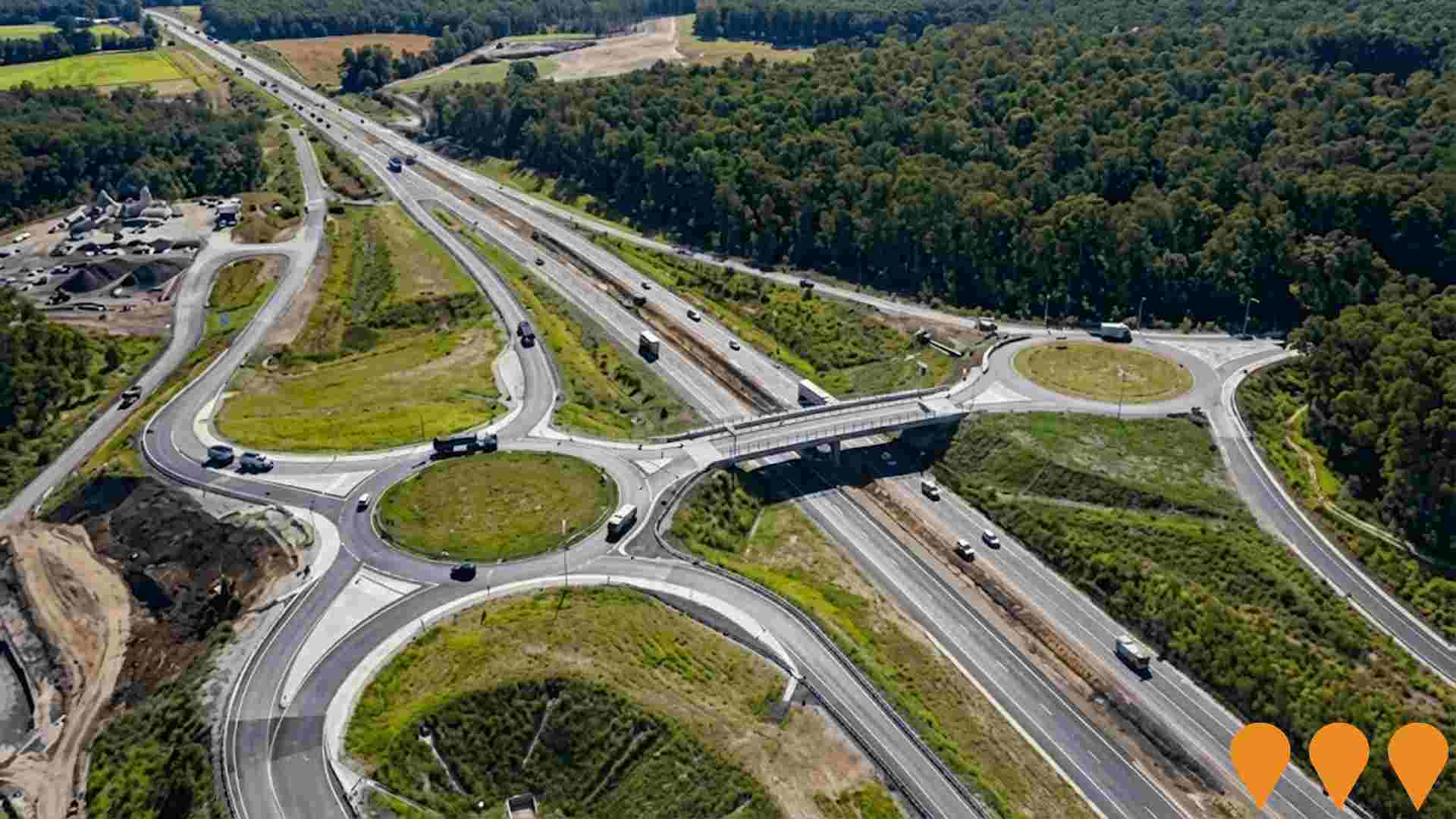
Forster Tuncurry Health Facility (Lower Mid North Coast Health Service Project)
A new public health facility for the Forster-Tuncurry area is being planned as part of the broader Lower Mid North Coast Health Service Project (combined with Manning Base Hospital Stage 2 redevelopment). The Forster facility will deliver emergency department, inpatient beds, outpatient and ambulatory care services. Site options are being evaluated near the existing Forster Private Hospital. Health Infrastructure NSW is leading planning and community consultation in partnership with Hunter New England Local Health District.

Forster Civic Precinct - Solaris
A completed mixed-use development providing new council facilities including a 2,000m2 public library, visitor information centre, customer service centre, flexible community spaces accommodating 200+ people, conference rooms, and underground parking. The civic facilities opened to the public on October 9, 2023. Future stages include seniors living apartments and retail facilities by the developer.
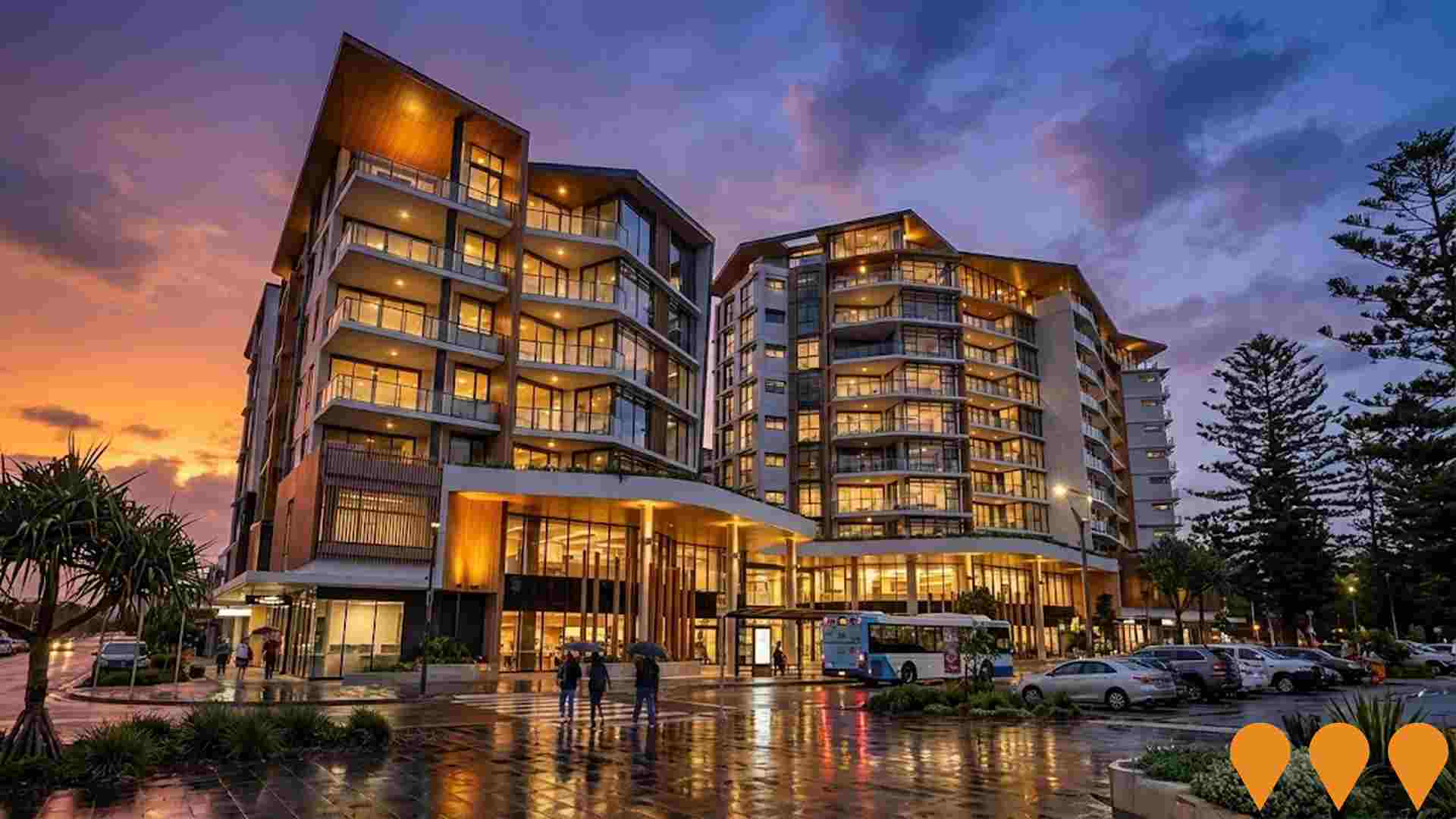
Tuncurry Village Hub Redevelopment
Redevelopment of the former Tuncurry Plaza into a modern shopping and lifestyle hub featuring fresh food, dining options, health services, community spaces, eco-friendly design, and convenient parking.

4-12 Breese Parade Large Format Retail Development
A large-format retail development offering up to 4,000 square metres of gross leasable area in the retail heart of Forster. The former MidCoast Council site was sold for $12.72 million and features prime positioning directly opposite Stockland Forster shopping centre with high exposure and accessibility. The development includes rear loading facilities and showroom space across a commanding 14,110mý site with B2 Local Centre zoning.

Forster Main Beach Masterplan
A comprehensive 30-year strategy to revitalize the Forster Main Beach precinct through staged development. Stage 1 has been completed with the new Surf Life Saving Club opening in 2024, and Ocean Baths facilities upgraded with new amenities, BBQ shelters, and accessible ramps. Future stages include The Pavilion cafe and amenities building, The Oasis public plaza, upgraded promenade with beach access, underground parking for 200 cars, and children's playground. The masterplan aims to create more green space, improve accessibility, modernize facilities, and strengthen community connections while maintaining the natural coastal character.

Forster and Old Bar New Ambulance Stations
New ambulance stations planned for Forster and Old Bar to improve emergency medical services coverage in the Great Lakes region. Part of the broader health infrastructure investment by the NSW Government to ensure emergency services are better equipped to serve the growing population in the Mid North Coast region.
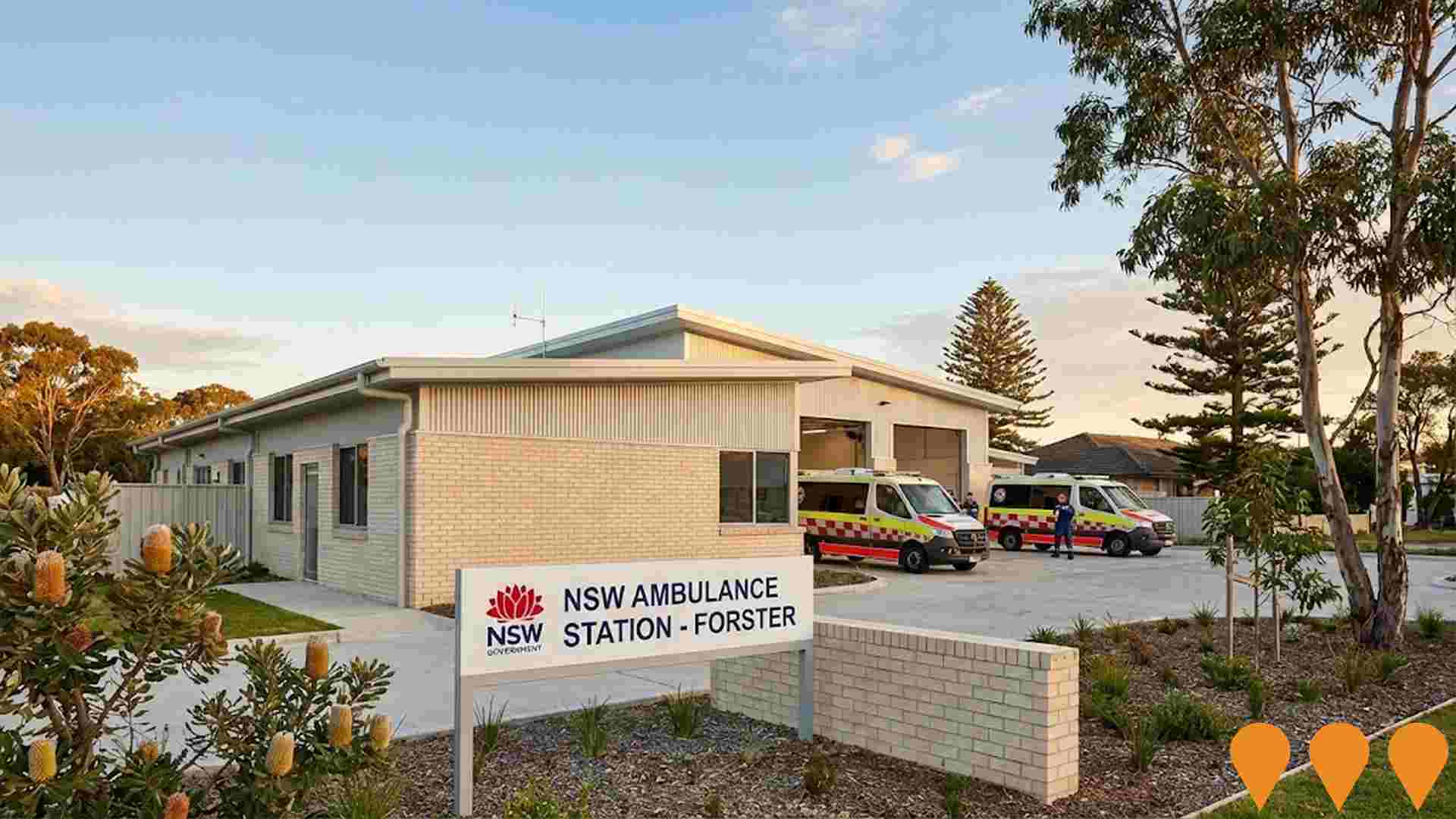
Forster Gateway Development - The Lakes Way
Proposed future development on a 25.12ha plot of land along The Lakes Way, Forster would accommodate a mix of residential, commercial and conservation zones. The site includes the Great Lakes Tavern and bottleshop, shopping complex, motel, cafe/bar and houses. The project has potential to provide approximately 135 dwellings in a variety of housing styles.
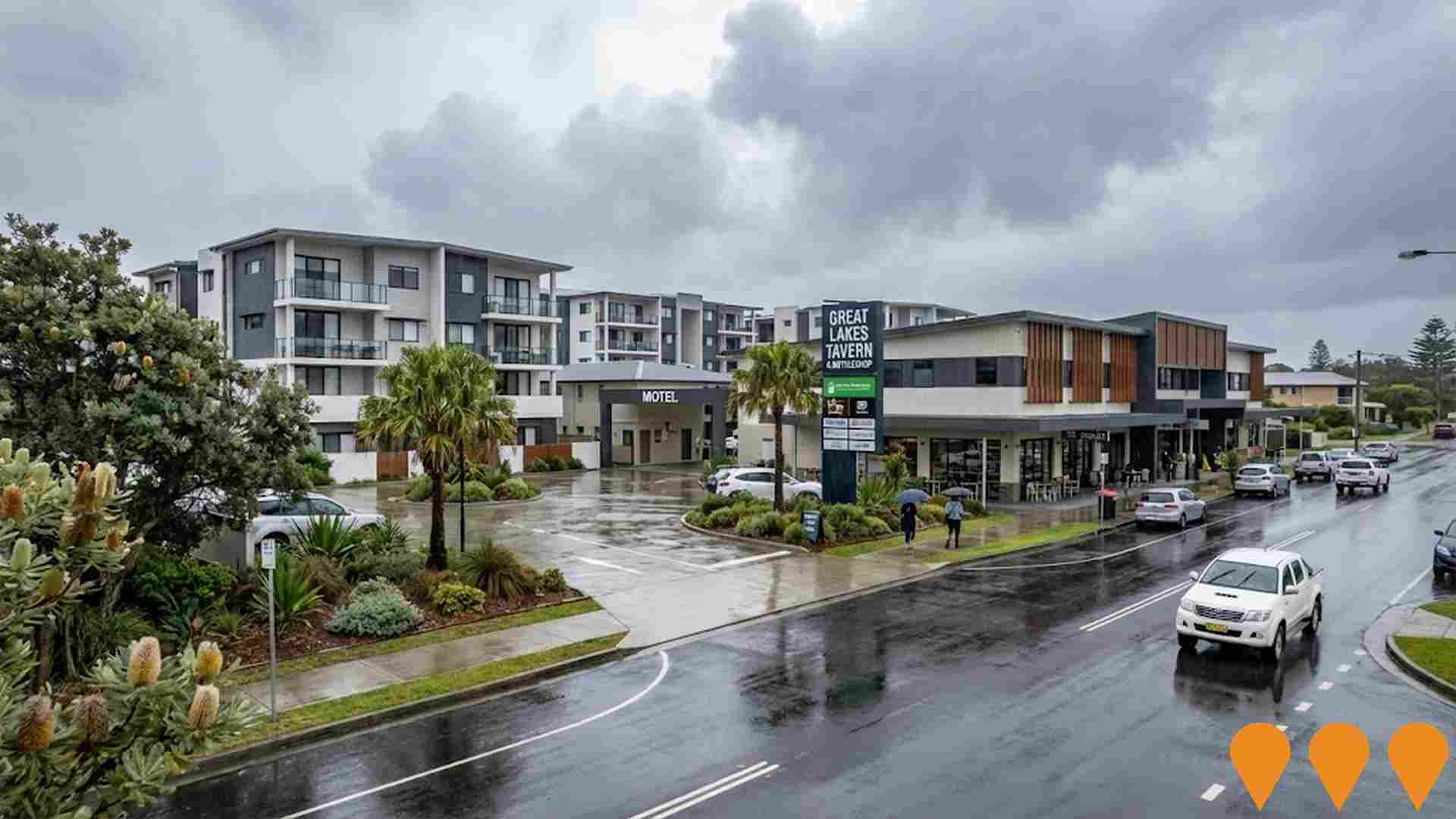
Employment
While Forster-Tuncurry Surrounds retains a healthy unemployment rate of 3.8%, recent employment declines have impacted its national performance ranking
Forster-Tuncurry Surrounds has a skilled workforce with the construction sector being particularly prominent. As of June 2025, its unemployment rate is 3.8%, slightly higher than Rest of NSW's rate of 3.7%.
The dominant employment sectors among residents are health care & social assistance, construction, and retail trade. The area has a significant specialisation in construction, with an employment share 1.6 times the regional level. In contrast, public administration & safety employs only 4.8% of local workers, below Rest of NSW's 7.5%. Labour force analysis shows that over the past year (June 2024 to June 2025), employment decreased by 0.0%, while the labour force increased by 0.8%, leading to a rise in unemployment rate by 0.8 percentage points.
Jobs and Skills Australia's national employment forecasts from May 2025 suggest that Forster-Tuncurry Surrounds' employment is likely to grow by approximately 6.5% over five years and 13.3% over ten years, based on weighted extrapolations of industry-specific projections.
Frequently Asked Questions - Employment
Income
Income metrics place the area in the bottom 10% of locations nationally according to AreaSearch analysis
Forster-Tuncurry Surrounds had a median taxpayer income of $39,905 and an average of $51,621 in the financial year 2022. This is lower than the national averages of $49,459 for median income and $62,998 for average income. By September 2025, estimates suggest the median income would be approximately $44,937 and the average income $58,130, based on a 12.61% growth in wages since 2022. According to the 2021 Census, incomes in Forster-Tuncurry Surrounds fell between the 9th and 10th percentiles nationally for households, families, and individuals. The income distribution showed that 27.4% of locals (1,979 people) earned between $800 and $1,499, contrasting with metropolitan regions where the leading bracket was $1,500 to $2,999 at 29.9%. After accounting for housing costs, 86.1% of income remained, which ranked at the 13th percentile nationally.
Frequently Asked Questions - Income
Housing
Forster-Tuncurry Surrounds is characterized by a predominantly suburban housing profile, with above-average rates of outright home ownership
The dwelling structure in Forster-Tuncurry Surrounds, as per the latest Census, consisted of 92.4% houses and 7.7% other dwellings. In comparison, Non-Metro NSW had 73.0% houses and 27.0% other dwellings. Home ownership in Forster-Tuncurry Surrounds was 54.3%, with the rest being mortgaged (31.3%) or rented (14.4%). The median monthly mortgage repayment was $1,500, below Non-Metro NSW's average of $1,517. The median weekly rent figure was $350, compared to Non-Metro NSW's $330. Nationally, Forster-Tuncurry Surrounds' mortgage repayments were lower at $1,500 versus the Australian average of $1,863, and rents were less at $350 compared to the national figure of $375.
Frequently Asked Questions - Housing
Household Composition
Forster-Tuncurry Surrounds has a typical household mix, with a higher-than-average median household size
Family households constitute 71.2% of all households, including 21.4% couples with children, 38.6% couples without children, and 10.4% single parent families. Non-family households account for the remaining 28.8%, with lone person households at 25.9% and group households comprising 3.0%. The median household size is 2.3 people, which is larger than the Rest of NSW average of 2.1.
Frequently Asked Questions - Households
Local Schools & Education
Educational outcomes in Forster-Tuncurry Surrounds fall within the lower quartile nationally, indicating opportunities for improvement in qualification attainment
The area has university qualification rates of 18.4%, significantly lower than the NSW average of 32.2%. This presents both a challenge and an opportunity for targeted educational initiatives. Bachelor degrees are the most common at 13.0%, followed by postgraduate qualifications (3.5%) and graduate diplomas (1.9%). Trade and technical skills are prominent, with 45.0% of residents aged 15+ holding vocational credentials - advanced diplomas (10.9%) and certificates (34.1%).
Educational participation is high at 25.5%, including 10.6% in primary education, 8.1% in secondary education, and 1.5% pursuing tertiary education. Forster-Tuncurry Surrounds has 4 schools with a combined enrollment of 455 students, operating under typical Australian school conditions (ICSEA: 964) with balanced educational opportunities. All 4 schools focus on primary education, with secondary options available in nearby areas. School places per 100 residents stand at 6.3, below the regional average of 10.4, indicating some students may attend schools in adjacent areas.
Frequently Asked Questions - Education
Schools Detail
Nearby Services & Amenities
Transport
Transport servicing is low compared to other areas nationally based on assessment of service frequency, route connectivity and accessibility
Forster-Tuncurry Surrounds has 232 active public transport stops, all of which are bus stops. These stops are serviced by 48 different routes that together provide 427 weekly passenger trips. The area's transport accessibility is rated as good, with residents located an average of 235 meters from the nearest stop.
On average, there are 61 trips per day across all routes, which equates to approximately one weekly trip per individual stop.
Frequently Asked Questions - Transport
Transport Stops Detail
Health
Health performance in Forster-Tuncurry Surrounds is well below average with prevalence of common health conditions notable across both younger and older age cohorts
Forster-Tuncurry Surrounds faces significant health challenges, with common conditions prevalent across both younger and older age groups. Private health cover is low at approximately 46%, covering around 3,351 people, compared to the national average of 55.3%.
The most common conditions are arthritis (12.3%) and mental health issues (8.4%). About 61.5% report no medical ailments, higher than Rest of NSW's 56.6%. The area has 30.9%, or about 2,233 people aged 65 and over, lower than Rest of NSW's 36.0%. Despite this, health outcomes among seniors are above average, outperforming the general population in health metrics.
Frequently Asked Questions - Health
Cultural Diversity
Forster-Tuncurry Surrounds is considerably less culturally diverse than average when assessed alongside AreaSearch's national rankings for language and cultural background related metrics
Forster-Tuncurry Surrounds, as per the census conducted on 29 June 2016, showed lower cultural diversity with 88.1% of its population being Australian citizens and 86.8% born in Australia. A majority, 97.1%, spoke English only at home. Christianity was the predominant religion, practiced by 50.3% of the population.
Judaism, while a minority, was overrepresented at 0.3% compared to the regional average of 0.1%. Regarding ancestry, the top three groups were English (33.0%), Australian (31.6%), and Irish (8.6%). Notably, Welsh (0.7%) Maltese (0.7%) and Scottish (8.6%) populations were disproportionately higher compared to the rest of NSW.
Frequently Asked Questions - Diversity
Age
Forster-Tuncurry Surrounds ranks among the oldest 10% of areas nationwide
Forster-Tuncurry Surrounds has a median age of 53, which is considerably higher than the Rest of NSW figure of 43 and substantially exceeds the national norm of 38. Relative to Rest of NSW, Forster-Tuncurry Surrounds has a higher concentration of 65-74 residents at 19.3%, but fewer 25-34 year-olds at 6.4%. This 65-74 concentration is well above the national figure of 9.4%. Between the 2021 Census and present, the 15 to 24 age group has grown from 7.5% to 9.2%, while the 75 to 84 cohort increased from 8.2% to 9.8%. Conversely, the 55 to 64 cohort has declined from 19.1% to 17.2%. Looking ahead to 2041, demographic projections reveal significant shifts in Forster-Tuncurry Surrounds's age structure. Leading this shift, the 65 to 74 group is projected to grow by 15%, adding 213 people and reaching a total of 1,606 from the current 1,392. Meanwhile, the 5 to 14 cohort grows by a modest 4%, adding 27 people.



